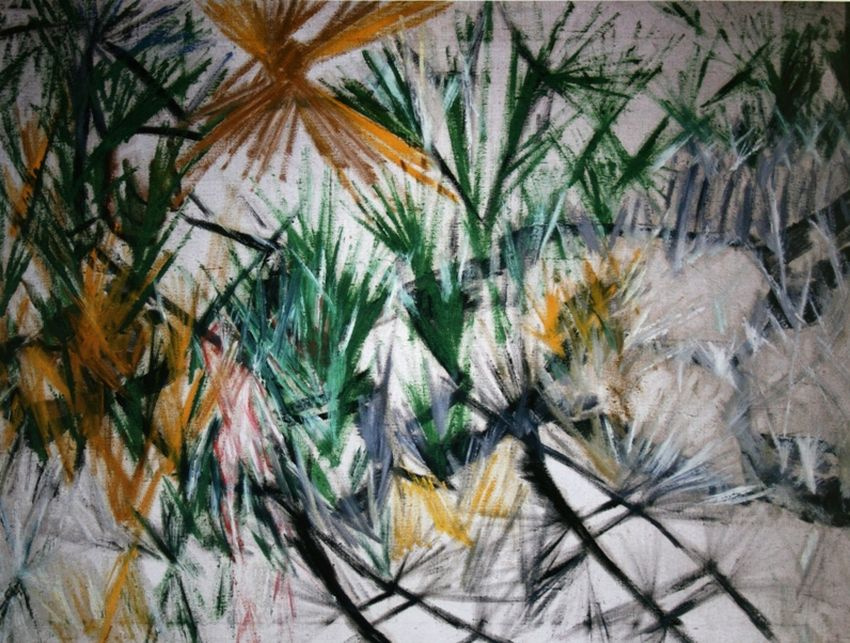log in
Enter site
Login to use Arthive functionality to the maximum
Radiant landscape
Mikhail Larionov • Painting, 1912, 71×94.5 cm
Description of the artwork «Radiant landscape»
When Mikhail Larionov was seven years old, he promised himself that even when he grew up, he would not forget how he saw the world in childhood. Luchism - the fulfillment of this promise. “To fix what we have, a camera was invented!” - said Larionov, and he began to write radiant paintings. It was the beginning of Russian abstractionism and the farewell of Larionov with neo-primitivism.
Luchism, whose founder and creator was Mikhail Larionov, called for the image not of objects, but of the rays that they reflect. According to the theory of Luchism, each person and each object emit a certain radiant energy. The interaction of anything and anyone is the intersection and reflection of these rays. Perhaps Larionov would have something to discuss with quantum physicists. He dreamed of ever inventing a device that captures these rays, with which it would be possible to measure the amount of love that a loved one is having for you.
And here we have an abstract radiant landscape. Despite the manifested irrelevance, the play of light and color, the naturalness of the lines leave no doubt that we see exactly the picture of nature. These rays seem so alive and "growing" that for a moment they even flashed the thought: maybe this is the best way to paint landscapes? The abstractness of the image is compensated for exclusively by natural natural colors: green foliage, yellow-orange solar flashes, white, and occasionally soft pink flowering, crowning the black flexible stems. The picture is filled with movement, there is a feeling that the artist depicted the process of growth itself.
The canvas fulfills a role uncharacteristic to it until now - there is no longer a border between its surface, looking and image. As if these Larion rays, spitting on all spatial-volume laws, penetrate the picture at once in all directions. Here is what Larionov wrote in the manifesto "Luchism": “This is almost the same as a mirage arising in the hot desert air, painting distant cities, lakes, oases in the sky - Luchism erases the boundaries that exist between the picture plane and nature”. Perhaps he did it. And the comparison with the mirage in the desert perfectly conveys the confused and tedious state captured in the picture.
The intersecting rays - energy and light - give the picture a shine, they become the starting point for immersion in sensations. By the way, Mayakovsky called Luchism as a cubist version of impressionism. And indeed in these pictures surprisingly combines constructive and clear form with the overwhelming flood of emotions. “Radiant pictures” are focused on sensations, their goal is to alarm and excite feelings. They do not violate familiar logic (as flying people chagall or inverted "Point of view" Burliuk), and there are generally outside of this logic, in another dimension. Here the law is the color combinations, contrasts and ratios, energy vectors and the game of textures. The radians saw in this approach going beyond the limits of space-time limitations. There are only rays, of which all is.
Author: Alain Esaulova
Luchism, whose founder and creator was Mikhail Larionov, called for the image not of objects, but of the rays that they reflect. According to the theory of Luchism, each person and each object emit a certain radiant energy. The interaction of anything and anyone is the intersection and reflection of these rays. Perhaps Larionov would have something to discuss with quantum physicists. He dreamed of ever inventing a device that captures these rays, with which it would be possible to measure the amount of love that a loved one is having for you.
And here we have an abstract radiant landscape. Despite the manifested irrelevance, the play of light and color, the naturalness of the lines leave no doubt that we see exactly the picture of nature. These rays seem so alive and "growing" that for a moment they even flashed the thought: maybe this is the best way to paint landscapes? The abstractness of the image is compensated for exclusively by natural natural colors: green foliage, yellow-orange solar flashes, white, and occasionally soft pink flowering, crowning the black flexible stems. The picture is filled with movement, there is a feeling that the artist depicted the process of growth itself.
The canvas fulfills a role uncharacteristic to it until now - there is no longer a border between its surface, looking and image. As if these Larion rays, spitting on all spatial-volume laws, penetrate the picture at once in all directions. Here is what Larionov wrote in the manifesto "Luchism": “This is almost the same as a mirage arising in the hot desert air, painting distant cities, lakes, oases in the sky - Luchism erases the boundaries that exist between the picture plane and nature”. Perhaps he did it. And the comparison with the mirage in the desert perfectly conveys the confused and tedious state captured in the picture.
The intersecting rays - energy and light - give the picture a shine, they become the starting point for immersion in sensations. By the way, Mayakovsky called Luchism as a cubist version of impressionism. And indeed in these pictures surprisingly combines constructive and clear form with the overwhelming flood of emotions. “Radiant pictures” are focused on sensations, their goal is to alarm and excite feelings. They do not violate familiar logic (as flying people chagall or inverted "Point of view" Burliuk), and there are generally outside of this logic, in another dimension. Here the law is the color combinations, contrasts and ratios, energy vectors and the game of textures. The radians saw in this approach going beyond the limits of space-time limitations. There are only rays, of which all is.
Author: Alain Esaulova


